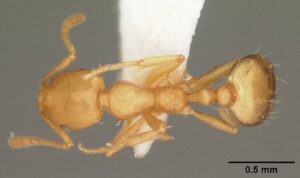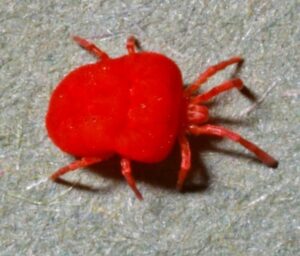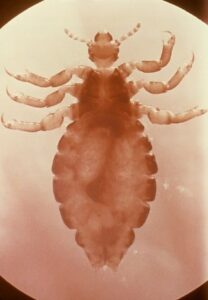Introduction
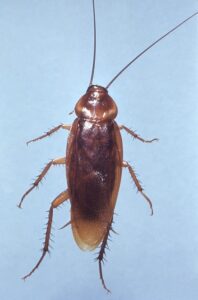
Cockroaches are known to have been present on Earth for nearly 350 million years. They are among the most familiar of all insect pests in residential and commercial buildings and facilities. They are especially present where food is prepared or sanitation is lacking. Their sizes vary considerably. Cockroaches are one of the most adaptable and successful insect groups. They are a high-risk pest and have been able to survive many changing environments.
Cockroaches can transfer disease-causing bacteria from their bodies to food products or cooking utensils as they search for food. Although they do not transmit any known serious illnesses to humans, they are associated with salmonella food poisoning, diarrhea, dysentery, and other gastrointestinal conditions. More importantly, cockroach feces and shed skins contain materials that can trigger allergic reactions and aggravate asthma, making them a major problem in homes, schools, and food retail facilities.
ETS has a comprehensive management plan to reduce and eliminate cockroaches in your home or business and reduce the risk of any future infestation. Advance techniques and non-chemical materials are being implemented to guarantee your safety.
There are about 3500 species of cockroaches worldwide, but few species are found in the UAE.
- German Cockroach – Blattella germanica (Linnaeus) – (Blattellidae: Blattodea)
- American Cockroach – Periplaneta americana (Linnaeus) – (Blattidae: Blattodea)
- Oriental Cockroach – Blatta orientalis ((Linnaeus) – (Blattidae: Blattodea)
1- German Cockroach:
General Description
Adult
- About 1.25 cm long.
- Grayish-tan or light brown in color, females darker than males.
- Two black longitudinal stripes on the pronotum.
- Wings cover the tip of the abdomen.
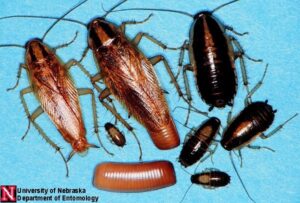
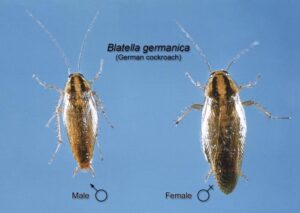
Nymph
- Smaller than adults (size depends on how many molts they have been through).
- Brownish-black with a pale tan stripe down the middle of the back.
Life Cycle and Common Characteristics:
- German cockroaches are one of the most important urban insects, and the most common cockroach species in houses, apartments, restaurants, and hotels.
- They are most commonly found in food preparation areas, where moist, warm harborage sites are available. They can also be found in dishwasher rooms, gym locker rooms, or anywhere warmth, moisture, and food are available.
- Adult females have a higher reproductive capacity and allowing populations to increase quickly if unchecked.
- Adult females produce a high number of capsules (4-8) in their lifetime.
- Large number (30-48) of eggs are produced per capsule/ootheca.
- There are six or seven nymphal stages, called instars, before the molt or ecdysis into the adult stage.
- The nymphal stage requires 40-125 days to complete.
- The high rate of nymph survival due to small size, makes nymphs more concealed and protected.
- A German cockroach who undergo the molt, it is teneral until its cuticle hardens within 1-3 hours during which it will darken in color.
- The German cockroach has a short period of development from egg to adult (as short as 36 days under ideal conditions).
- Adults live up to a year, but most will die from various causes long before that time.
- Nymphs have habits similar to those of adults, and they are active at night.
- German cockroaches hide and food, where they forage at night, sightings of several German cockroaches during the day may indicate that populations are large and stressed for food or harborage.
- They feed on a variety of foods, and adults can survive up to one month without food. They are more dependent on water and die in one or two weeks if moisture is not available.
- German cockroaches generally prefer to forage within several feet of their harborage areas, but can be much more mobile in some circumstances.
- Adult males and non-gravid females are the most mobile stages and can move from the main harborage to other areas of a structure, particularly when crowding occurs.
- They are also readily transported unintentionally by humans in shopping bags, bags of produce, cardboard cartons, furniture, purses, book bags, and other items.
Damage and Medical Implications
- Cockroaches can be detected by their obnoxious odor or damage, or by the fecal matter (called frass) that they produce or deposit. These clues can aid in diagnosing a cockroach problem.
- Cockroaches are unlikely to bite humans because their mouthparts are not large or powerful enough to inflict a “bite”.
- The cockroach damage is a result of their habit of feeding and harboring in damp and unsanitary places, such as sewers, garbage disposals and damp and unsanitary areas of kitchens, bathrooms and indoor storage areas.
- Cockroaches spread filth and germs from these sources onto food supplies, food preparation surfaces, dishes, utensils and other surfaces.
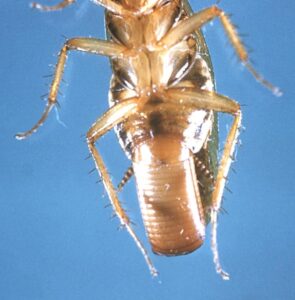
- Cockroaches contaminate far more food than they eat.
- Because of the odor imparted by cockroaches, most people are disgusted and repulsed by their presence.
- Cockroaches produce odorous secretions from various points in their bodies, and these secretions can affect the flavor of foods.
- The presence of cockroaches constitutes an important source of health-threatening allergens and can even trigger life-threatening asthma attacks.
- Different forms of gastroenteritis potentially may be diseases transmitted by cockroaches. These include salmonella food poisoning, nausea, abdominal cramps, vomiting, diarrhea, dysentery and other illnesses. The organisms causing these diseases are carried on the legs and bodies of cockroaches, and are deposited on food and utensils as cockroaches forage.
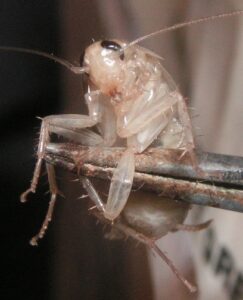
- Cockroach excrement and cast skins contain a number of allergens to which many people exhibit allergic responses, such as skin rashes, watery eyes and sneezing.
- Cockroaches are not associated with severe illnesses or disease outbreaks.
2 – American Cockroach
General Description
Adult
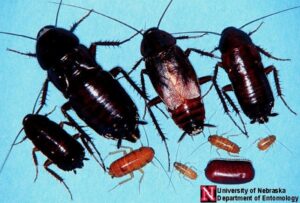
- One and one-third to 2.5 – 4 cm long.
- Reddish-brown, with a light-colored ring along the edges of the pronotum.
- Male wings cover the tip of the abdomen, female wings do not.
Nymph
- Smaller than adults (size depends on how many molts they have been through).
- Small nymphs grayish-brown, larger nymphs redlish-brown.
Life Cycle and Common Characteristics:
- The American cockroaches are the largest common building-infesting cockroach species, especially in manholes.
- The female drops her egg capsule (ootheca) within a day after it is formed. Sometimes it is dropped near a food source or in a protected area.
| · The egg capsule is 0.75 cm long (length less than width).
· Egg capsules are formed at the rate of about 1 per week. The female produces 15 – 90 capsules, and each capsule contains 14 – l6 eggs. |
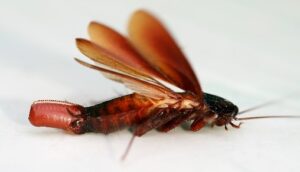
Toby Hudson |
- Nymphs hatch after 50 to 55 days.
- Each nymph molts 9 to 13 times to reach maturity.
- Nymphal stage requires 160 – 900 days to complete, depending on environmental conditions.
- Adult females live up to 15 months.
- Adults may live for 3 months without food and 1 month without water.
- Adults favor warm, moist habitats, often close to the ground or even underground.
- Cockroaches favor warm, moist habitats, often close to the ground or even underground.
- Indoors, they are often found in damp basements, crawlspaces, pipe chases, steam tunnels, and floor drains.
- In schools, they are often abundant in locker rooms and near pool areas and may inhibit water heaters, furnaces, and other warm, moist places.
- They can live outdoors during warm months, around dumpster areas, or near access to sewers.
- This species feeds on a variety of foods, but favors decaying organic matter and starchy materials.
- American cockroaches rarely fly unless temperatures exceed 45°C. During hot weather outdoors they can be very active flyers.
Damage and Medical Implications
- Cockroaches can be detected by their obnoxious odor or damage, or by the fecal matter (called frass) that they produce or deposit. These clues can aid in diagnosing a cockroach problem.
- Cockroaches are unlikely to bite humans because their mouthparts are not large or powerful enough to inflict a “bite”.
- The cockroach damage is a result of their habit of feeding and harboring in damp and unsanitary places, such as sewers, garbage disposals and damp and unsanitary areas of kitchens, bathrooms and indoor storage areas.
- Cockroaches spread filth and germs from these sources onto food supplies, food preparation surfaces, dishes, utensils and other surfaces.
- Cockroaches contaminate far more food than they eat.
- Because of the odor imparted by cockroaches, most people are disgusted and repulsed by their presence.
- Cockroaches produce odorous secretions from various points in their bodies, and these secretions can affect the flavor of foods.
- The presence of cockroaches constitutes an important source of health-threatening allergens and can even trigger life-threatening asthma attacks.
- Different forms of gastroenteritis potentially may be diseases transmitted by cockroaches. These include salmonella food poisoning, nausea, abdominal cramps, vomiting, diarrhea, dysentery and other illnesses. The organisms causing these diseases are carried on the legs and bodies of cockroaches, and are deposited on food and utensils as cockroaches forage.
- Cockroach excrement and cast skins contain a number of allergens to which many people exhibit allergic responses, such as skin rashes, watery eyes and sneezing.
- Cockroaches are not associated with severe illnesses or disease outbreaks.
3 – Oriental Cockroach
General Description
Adult
- 5 cm (males) to 2.5 – 3.5 cm (females) long.
- Very dark brown to shiny black in color.
- Male wings are wide and short, leaving the last few abdominal segments exposed.
- Females are wingless, but have short triangular wing pads behind the pronotum.
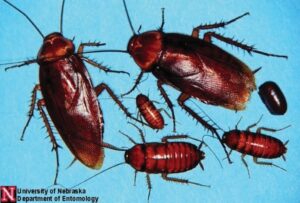
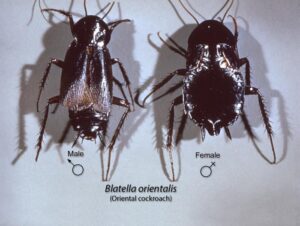
Nymph
- Smaller than adults (size depends on how many molts they have been through).
- First stage nymphs are pale tan, all other nymph stages reddish brown to black in color and difficult to distinguish from American cockroach nymphs.
Life Cycle and Common Characteristics:
- The Oriental cockroaches have a more seasonal life cycle than other cockroach pest species, with females producing eggs from spring to midsummer.
- The female carries an egg capsule for about 30 hours, after which it is either dropped or attached using saliva to a protected surface near a food supply.
- Females produce an average of 8 capsules, each containing 16 eggs, which hatch in about 60 days under room conditions.
- Nymphs molt 7 – 10 times and the nymphal stages take several months to a year to complete.
- This cockroach species has a seasonal developmental cycle. The high number appears in spring or early summer.
- Nymphs and adults have similar habits and are found associated with decaying organic matter indoors and out.
- Adults can live about one month without food and up to two weeks without water.
- Adults do not fly.
- Orientals prefer moist areas near or below ground level.
- These cockroaches are poor climbers and are rarely seen on walls or ceilings.
- They favor areas with decaying organic matter, such as sewers, drains, landfills, and mulch beds.
- In buildings, they often inhabit damp basements, lower areas of pipe chases, steam tunnels, boiler rooms, pools, and locker rooms.
- They can travel through such areas to migrate from one part of a building to another.
- They can survive in cooler temperatures than other common cockroach pests and often enter a building through the floor drains.
- Oriental cockroaches favor decaying organic matter and starchy food materials. They feed on rubbish and are often found outdoors near dumpsters or around building perimeters. The adults can live about one month without food and up to two weeks without water.
Damage and Medical Implications
- Cockroaches can be detected by their obnoxious odor or damage, or by the fecal matter (called frass) that they produce or deposit. These clues can aid in diagnosing a cockroach problem.
- Cockroaches are unlikely to bite humans because their mouthparts are not large or powerful enough to inflict a “bite”.
- The cockroach damage is a result of their habit of feeding and harboring in damp and unsanitary places, such as sewers, garbage disposals and damp and unsanitary areas of kitchens, bathrooms and indoor storage areas.
- Cockroaches spread filth and germs from these sources onto food supplies, food preparation surfaces, dishes, utensils and other surfaces.
- Cockroaches contaminate far more food than they eat.
- Because of the odor imparted by cockroaches, most people are disgusted and repulsed by their presence.
- Cockroaches produce odorous secretions from various points in their bodies, and these secretions can affect the flavor of foods.
- The presence of cockroaches constitutes an important source of health-threatening allergens and can even trigger life-threatening asthma attacks.
- Different forms of gastroenteritis potentially may be diseases transmitted by cockroaches. These include salmonella food poisoning, nausea, abdominal cramps, vomiting, diarrhea, dysentery and other illnesses. The organisms causing these diseases are carried on the legs and bodies of cockroaches, and are deposited on food and utensils as cockroaches forage.
- Cockroach excrement and cast skins contain a number of allergens to which many people exhibit allergic responses, such as skin rashes, watery eyes and sneezing.
- Cockroaches are not associated with severe illnesses or disease outbreaks.

